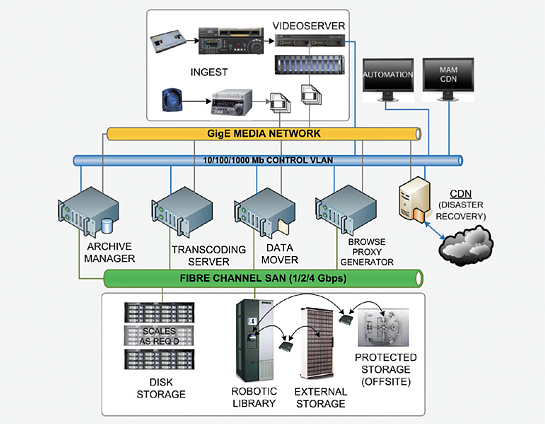Dimensioning the Archive

Media and entertainment have a dilemma when it comes to the preservation of their legacy and current media assets. The tasks of retaining these valuable assets have been an industry conundrum for as long as videotape has existed. It goes without saying that as technologies continue to advance, so will the evolutional changes necessary to address the new formats, the expiring transports, and the decisions on what to do with all these assets going forward.
The quantity of these assets is never going to diminish unless people decide to just stop saving them. It's highly unlikely the potentially millions of individual tapes stored in vaults or hidden in desks, boxes and basements will ever get transferred to a different medium or permanently archived to an extensible format.
Couple this with the unrelenting growth in media, now held as files, with the gradual expiration of those devices that can reproduce the legacy content, and you'll see there are no points where the curves on the graphs can finally cross.
A UNIVERSAL PROBLEM
The process of archiving valued assets for the future is a task that nearly everyone with any form of electronic media system addresses. For the everyday home user, retaining your personal digital photographic images or all those "paper free" monthly statements is just a microscopic example of what corporations and broadcasters must face on a regular basis.
Home users might use DVDs or external hard disks as their "archive/backup" medium. Recent alternatives now offer migrating the assets to the cloud, i.e., buying into a service that gets their assets off the overcrowded PC and to another secure location—a temporary, but protective fix at best.

The basic architecture of an archive system consisting of ingest components (videotape, file-based elements or videoserver) attached to a media network, which interfaces to the archive serving elements comprised of the archive manager, proxy/browse generator, data mover and an optional content distribution network/disaster recovery WAN. Content migrates through the archive server systems, is transcoded or rewrapped, then sent to spinning disk storage or a datatape robotic library. Physical media remains in the library, shelved locally or moved offsite to protected storage. Broadcast news organizations for years have each developed their own practices for retaining their assets—most of them remain "manual" in nature. The advent of newsroom computer systems coupled to file-based editing platforms (e.g., Avid iNews/Interplay or Grass Valley Aurora coupled with AP ENPS) made it far easier to manage, catalog and search their assets. However, each platform requires yet another set of hardware, software and physical media that integrates with their editing/NCRS systems. This kind of system is appropriately known as the "archive."
Archiving takes on two significant dimensions: One deals with current and future assets; the other addresses legacy assets. In either case, not only must an appropriate format for long-term preservation be determined (and they may each be different), but the allocation of ongoing labor and resources needed to manage, transfer and annotate the assets must also be provided. Any level of automation, which can be applied to these processes, is money well spent since those are upfront, capitalized costs that can be accounted for quite differently than ongoing operational expenditures, such as human labor.
Preserving assets for the long term requires understanding and determining a value for how important that asset may be in the future. Deciding the level of image quality that should be applied in order to retain that value for an undetermined length of time is a key element in deciding the archive dimensions.
The film industry began addressing these issues when the explosive vulnerability of their nitrate film assets was discovered decades ago. For example, it is believed, per Cinecon.org, that "83 percent of American silent films are considered lost," not only because of deterioration, but also due to the lack of ambition, foresight, labor availability and technical capability necessary to preserve that material safely.
COSTS & BENEFITS
Media and entertainment continue to deal with not only the physical aspects of archiving, but also with the intellectual property rights issues that remain important elements to preservation and repurposing. The recent advancements in preservation technologies developed to aid in the recovery of damaged content have produced new business opportunities, from which all of us have benefited greatly. Today's modern digital techniques being applied to resurrecting those nearly lost assets are extending the rationale for archiving of not only those precious, priceless memories, but it is helping all forms of business to justify the investments necessary to add archiving to their enterprises.
When prescribing a formula for archiving your assets consider such elements as the impact of reducing the current storage space for those legacy videotape assets. Include in the equation: the value of the returned real estate, power to keep the space properly conditioned, and the reduction of risks associated with any form of loss, i.e., fire, theft or unauthorized duplication. Find a solution that can grow as demands increase. Leverage storing, not only media assets, but also other important business assets (records, databases, manuals, etc). Be sure the track record of the media you'll employ is sustainable.
Choices made 10 years ago may no longer be usable today, forcing additional costs for the migration of existing digital assets into the solution. Select a compression technology appropriate for the media (not Long-GOP MPEG, but maybe JPEG2000). Look into media asset management, metadata schema, search capabilities, and cross platform integration—all elements to be addressed before committing to purchase.
In future columns we'll look at the archive platform itself, the horsepower needed for the components, how those elements relate to system bandwidth, tape drives and media formats and an intro to the standards related to archives and media preservation.
Karl Paulsen is a SMPTE Fellow, SBE Life Member and Certified Professional Broadcast Engineer. Contact him ativideoserver@gmail.com
The professional video industry's #1 source for news, trends and product and tech information. Sign up below.

Karl Paulsen recently retired as a CTO and has regularly contributed to TV Tech on topics related to media, networking, workflow, cloud and systemization for the media and entertainment industry. He is a SMPTE Fellow with more than 50 years of engineering and managerial experience in commercial TV and radio broadcasting. For over 25 years he has written on featured topics in TV Tech magazine—penning the magazine’s “Storage and Media Technologies” and “Cloudspotter’s Journal” columns.
